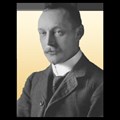Story
Thurston Laidlaw Shoosmith was born in 1865 into an affluent middle class family living at Ivy Towers, the gothic-styled house his father William Shoosmith had constructed in 1870 at 30 Billing Road, Northampton.
William was a well-respected solicitor who in 1845 established the law firm 'William Shoosmith' that would later become 'Shoosmith & Sons', followed by 'Shoosmiths & Harrison', eventually growing into the nationally recognised law firm 'Shoosmiths'. Thurston was educated at Northampton Grammar School before joining his father's firm in 1895. He would later become town clerk.
Growing up wealthy afforded a life in which family members were encouraged to paint. Thurston's mother, born Frances Buxton, was from a family who had been woodstaplers, and she and William had 5 sons and 3 daughters. Thurston was given the nickname 'Thursie', and even at his office at the firm he was referred to as 'Mr Thursie'.
It was common for artistic middle class households to receive tuition from a visiting art master, though it is not known if this was the case for the Shoosmith family. Thurston received no formal artistic training, but showed well-developed skills in his adolescent drawings. However, he was not particularly talented, and reached that stage primarily through determination and practice.
Thurston loved swimming, and spent plenty of time giving swimming lessons at Northampton's Midsummer Meadow on the banks of the River Nene. He had a kindly, generous, and passive nature, and unusually for the time, was a vegetarian.
In the local art community, Thurston had a great impact. He contributed to the cost of an art gallery at what is now The Northampton Museums and Art Gallery, and was the very first president of the Town and County Art Society.
He painted mostly with watercolours - a difficult technique to perfect, due to it being easily overworked with no way to undo mistakes. Some have derided his work as derivative, but Thurston evolved a style of his own, both distinctive and subtle. He painted many scenes from around Northampton, including several harsh industrial landscapes, considered a crude subject at the time. John Ruskin reportedly said during a lecture in 1884: "I have written fifty times, if once, that you can't have art where there is smoke..."
In the 1880's and 90's, Thurston travelled around Europe, including France, Belgium and Germany, taking sketches which he would then paint. Some of his most technically impressive works are arguably from this period, depicting bustling city and harbour scenes, backdropped by towering churches and continental streets.
At the beginning of the 1900's, Thurston increasingly spent his summer holidays travelling around the UK, in both cities and countryside, including Bristol, Ipswich, and Newcastle. He continued to controversially paint industrial scenes, and his works provide an important record of industrial history on the canals and rivers, which even into the 1930's were the lifeblood of manufacturing industry, and the principal means of transporting raw materials and completed products.
In the early 20th century, Thurston received an international reputation through the publication of his work in The Studio magazine, which proudly proclaimed in its title "with offices in London, Paris and New York". His influence was recognised by the Victoria and Albert Museum, and the Leeds City Art Gallery, who both acquired examples of his work.
Thurston remained in the family home until 1920, when he moved to Beckett House, Derngate. Upon retiring from legal practice to focus on painting, he gave his share of the partnership to Frank Harrison, who continued to run Shoosmiths & Harrison after the Shoosmiths had left.
 Campaign by
Campaign by